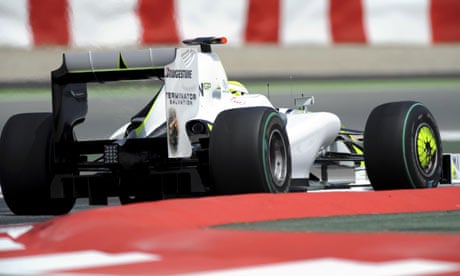At 8am yesterday, two hours before practice was due to begin for tomorrow's Spanish grand prix, a large red box was unloaded by forklift from a delivery truck with an Italian registration. The flat packing case, measuring 3 metres by 1.5 metres, was manoeuvred into the Ferrari area where the latest car parts were swiftly unpacked.
It was part of a never-ending development process that has been accelerated by lessons learned in the first four races of the season. After grands prix in Australia, Malaysia, China and Bahrain the teams have been able to return to their European bases for two weeks of work. Ferrari, along with McLaren and BMW, were the pre-season favourites but, instead of leading the way in the season's opening leg, all three have been forced to play catch-up thanks to the unexpected level of competitiveness displayed by Brawn, Red Bull Racing and, to a lesser degree, Toyota.
Development has always been part of a routine that exists from the moment a new car first turns a wheel. When McLaren gave Lewis Hamilton a car capable of winning the championship in 2008, they made approximately 3,000 changes, some so small they were invisible to the untrained eye. But this year's schedule of improvement has increased in significance because of the far-reaching revisions to the technical regulations for 2009 and their successful interpretation, particularly by Brawn.
The blessing conferred by the sport's governing body on the diffuser used by Brawn, Toyota and Williams has prompted the burning of midnight oil as McLaren, Ferrari and the rest introduce the aerodynamic device which is alleged to be worth as much as half a second a lap. Brawn say there is more to their car than merely the diffuser, a fact supported by Red Bull winning a race without one, but such an uncomfortable truth has done little to stem the frantic reworking of the cars at Ferrari and elsewhere.
"The first race in Europe usually represents something of a second start to the season," said Mario Theissen, BMW's director of motor sport. "For the BMW Sauber F1 Team, this applies more so than usual this year as we cannot be satisfied with the first four races. After our positive winter testing, all of us envisaged a rather different start. The car is not fast enough and we have only one podium finish – Nick Heidfeld's second in Malaysia.
"We are approaching this challenge in a positive way and we are working intensively to get back to our old form. We have brought an extensive aerodynamics-focused development package to Barcelona and we are already working on further upgrades."
BMW finished a strong third behind Ferrari and McLaren in the 2008 constructors' championship thanks in part to Robert Kubica scoring BMW's first win in Canada. BMW are sixth with a mere four points, less than a tenth of Brawn's tally. McLaren are marginally better off with 13 points thanks to Hamilton scoring in the past three races and a fifth place for Heikki Kovalainen in China.
Unlike BMW, McLaren recognised immediately that their 2009 contender was off the pace and began a series of upgrades that were introduced during the so-called 'flyaway races' outside Europe.
"The schedule for the first four races was very tough for everyone," said Hamilton. "So coming back to Europe almost feels like a fresh start. After such a positive performance in Bahrain, we're fully aware that the characteristics of the Barcelona track won't suit our car so well. In addition, we won't have the bigger upgrades of some of the other teams as we already introduced several new parts during the opening flyaways, so it will be interesting to see where we sit in the order.
"Nevertheless the engineers are optimistic that our new diffuser and front wing will once again help us to make progress towards the front of the grid."
If BMW have made the most wide-ranging changes, then Ferrari are not far behind with heavily revised aerodynamics, a factor that is more critical on the Circuit de Catalunya than anywhere else. Brawn may have made comparatively few changes thanks to having already used up most of their limited resources and, more important, the car being quick in the first place but, as their team principal, Ross Brawn, points out, there is no room for complacency.
"The team had to make a tremendous effort simply to have two cars on the grid for the first race in Melbourne," said Brawn. "The success we have achieved has been a well-deserved reward for all our hard work, which has been supported by the commitment of our engine partner Mercedes-Benz. The short break since returning from Bahrain has enabled the team to regroup in Brackley and spend time reflecting on our first four races.
"The field has compressed considerably since Australia and the performance margins at the front are now very tight indeed. Whilst we have been away racing over the past few weeks, the factory has been working extremely hard on our upgrade package for the car."
The true value of such concentrated effort across the board will not become apparent until the end of 66 laps tomorrow afternoon. The chances are that, despite the remarkable endeavour, the status quo will remain.
